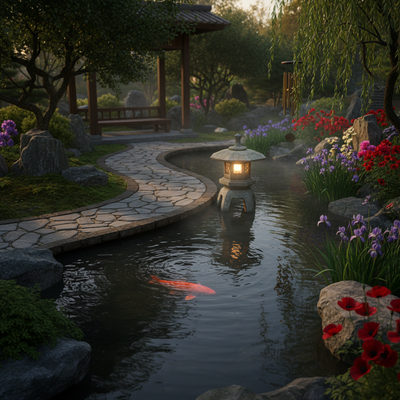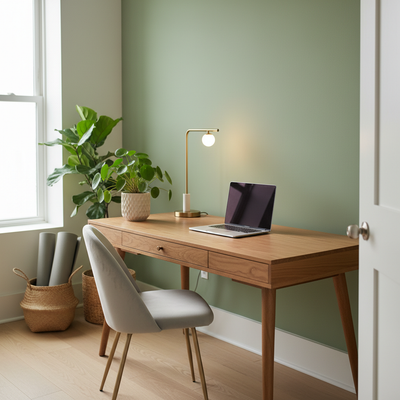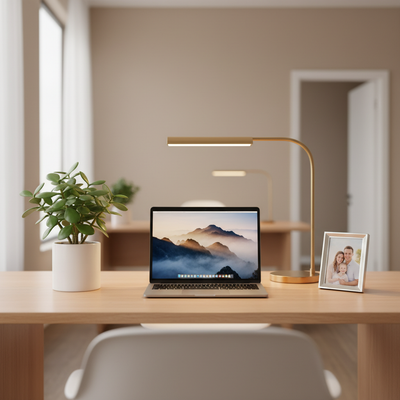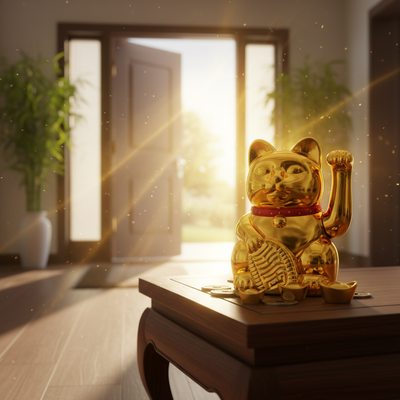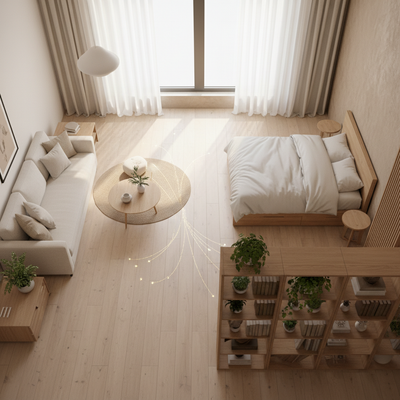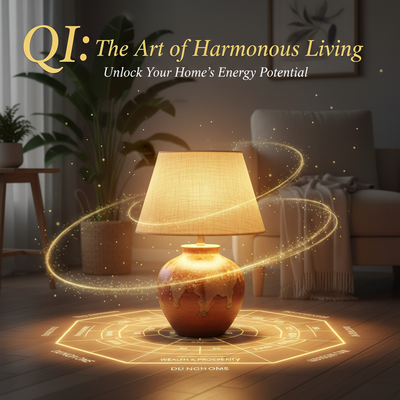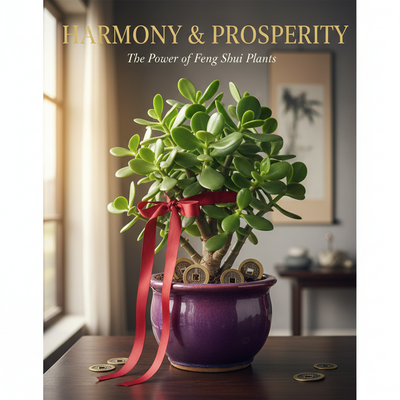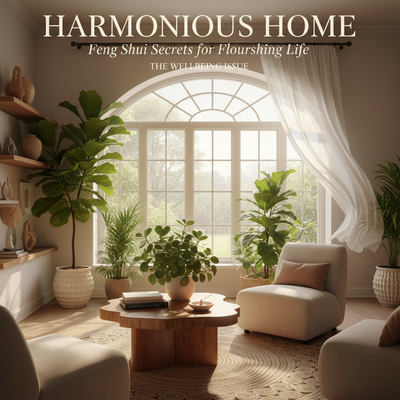Your garden is more than just plants; it's a living part of your home and inner world. You want to create a beautiful outdoor space that feels just right. This desire connects to an ancient idea called Qi, or life energy. This article will teach you how to use feng shui garden colors to work with that energy. Feng shui garden colors are a powerful way to balance the Five Elements, improve the positive flow of Qi, and create a space that helps your health, happiness, and dreams. When you choose colors on purpose, you change your garden from just pretty to truly healing.
The Heart of the Space

Before we look at specific colors, you need to understand the main goal of a feng shui garden. It's not about strict rules or superstition; it's about creating a living space that builds and moves positive energy, which makes you feel better.
Understanding Garden Qi
Qi is the invisible life energy that flows through everything, including your home and garden. Think of it like a gentle stream. When the stream flows smoothly and curves gracefully, it brings life and health. If it gets blocked or stops moving, it can make you feel uneasy. A well-designed feng shui garden helps Qi flow freely, gathering positive energy and spreading it through your property and your life. Every part, from a curved path to the color of a flower, affects this flow.
More Than Pretty Flowers
In feng shui, every choice is made with purpose. The colors you pick are not just to look nice; they are careful decisions to invite specific energies into your life. The goal is to create a space that actively helps your personal dreams. Are you looking for career growth, better health, or stronger relationships? By understanding how colors work energetically, you can design a garden that becomes a powerful helper in reaching these goals.
The Foundation of Color
The main theory behind feng shui color choices is the system of the Five Elements. This framework gives you the "why" behind color suggestions, helping you make smart decisions that go far beyond a simple list of color meanings. It's about understanding how colors work together.
The Five Elements
Each of the Five Elements represents a different type of energy and matches specific colors, shapes, and materials. Understanding them is the key to creating balance.
- Wood: Represents growth, life, expansion, and family.
- Fire: Represents passion, energy, expansion, and recognition.
- Earth: Represents stability, care, protection, and relationships.
- Metal: Represents clarity, precision, efficiency, and joy.
- Water: Represents flow, wisdom, abundance, and career.
The Productive Cycle
The Five Elements exist in a creative relationship called the Productive Cycle. This cycle shows how elements—and their matching colors—feed and support each other. Using this cycle helps you combine colors to encourage growth and positive results.
- Water (blue, black) -> feeds -> Wood (green, brown)
- Wood (green, brown) -> fuels -> Fire (red, orange, bright yellow)
- Fire (red, orange) -> creates -> Earth (sandy, light yellow, earthy tones)
- Earth (sandy, earthy) -> produces -> Metal (white, gray, metallics)
- Metal (white, gray) -> holds -> Water (blue, black)
The Destructive Cycle
There is also a Destructive Cycle, which is equally important for creating balance. Understanding this helps you avoid placing colors together that create energy conflict. For example, Water puts out Fire. This means placing a large blue water feature (Water) right next to a bright red flower bed (Fire) meant to boost your reputation could weaken its effect. This isn't a strict rule to fear, but a tool for creating harmony and making sure your intended energies are supported, not weakened.
| Element | Colors | Energy/Meaning | Garden Materials | Shapes |
|---|---|---|---|---|
| Wood | Green, Brown | Growth, Vitality, Family | Wood furniture, tall plants, columns | Columnar, Rectangular |
| Fire | Red, Orange, Purple, Bright Yellow | Passion, Fame, Energy | Lighting, BBQ, fire pits | Triangular, Pointed |
| Earth | Sandy, Light Yellow, Earthy Tones | Stability, Nurturing, Health | Clay pots, stones, soil | Square, Flat |
| Metal | White, Gray, Metallics | Clarity, Precision, Joy | Metal furniture, wind chimes, spheres | Round, Oval, Arch |
| Water | Blue, Black | Flow, Abundance, Career | Fountains, ponds, dark mulch | Wavy, Asymmetrical |
Mapping Your Garden's Energy
Now that you understand the elements and their colors, how do you know where to place them? The Bagua map gives you a practical way to apply color precisely to target specific areas of your life.
What is the Bagua?
The Bagua is the energy map of your space. It's a three-by-three grid where each of the nine sections matches a key life area. This system is a powerful tool that comes from the centuries-old I-Ching, giving it deep historical authority and a proven track record. To use it, you line up the bottom row of the grid (Knowledge, Career, Helpful People) with the main entrance to your garden or the wall of your house that the garden is on. This map shows you which part of your garden affects which part of your life.
Nine Bagua Areas Guide
Here is a guide to each of the nine Bagua areas, their matching elements, and how to activate them with color.
-
North: Career & Path in Life
- Element: Water
- Colors: Blue, Black
- Garden Ideas: A small, gently flowing water feature is perfect here. Use black or dark blue planters. Plant blue-flowering hydrangeas, delphiniums, or deep purple salvia to activate career energy.
-
Northeast: Spirituality & Self-Cultivation
- Element: Earth
- Colors: Dark Blue, Green, Black
- Garden Ideas: This is the perfect spot for a quiet meditation corner or a rock garden. Use earthy tones in stones and pavers. Plants with deep green leaves create a sense of peace and quiet thinking.
-
East: Health & Family
- Element: Wood
- Colors: Green, Brown
- Garden Ideas: This area thrives with lush, healthy green plants. Tall, column-like plants and trees are excellent here. Bamboo, with its rapid growth, is a powerful symbol of life. A wooden bench invites family connection.
-
Southeast: Wealth & Abundance
- Element: Wood
- Colors: Green, Purple, Red, Gold
- Garden Ideas: To attract wealth, support the Wood element with vibrant green plants. Add accents of purple or red flowers. A small water feature is also good here, as Water feeds Wood. Think of a "money plant" like Jade in a beautiful pot.
-
South: Fame & Reputation
- Element: Fire
- Colors: Red, Orange, Bright Yellow, Purple
- Garden Ideas: This is the power area for recognition. Use bold, fiery colors. Plant red roses, orange marigolds, or sunflowers. Outdoor lighting, a fire pit, or a BBQ grill strongly activates this area's energy.
-
Southwest: Love & Relationships
- Element: Earth
- Colors: Pink, Red, Yellow, Earthy Tones
- Garden Ideas: To nurture love, focus on pairs. Two matching chairs, two identical planters, or two rose bushes. Pinks and reds are the colors of romance. Earthy tones from clay pots or stone paths provide stability.
-
West: Children & Creativity
- Element: Metal
- Colors: White, Gray, Metallics
- Garden Ideas: Stimulate creativity with the Metal element. Plant white flowers like daisies or cosmos. A metal wind chime adds both sound and metallic energy. Round shapes, like spherical garden ornaments or a circular patio, are ideal.
-
Northwest: Helpful People & Travel
- Element: Metal
- Colors: White, Gray, Black
- Garden Ideas: To attract mentors and support, strengthen the Metal element. Use gray stone pavers and white flowering plants. A sculpture made of metal can act as a powerful anchor. This is also a great place for a bird feeder to invite helpful energy.
-
Center: Health & Well-being
- Element: Earth
- Colors: Yellow, Sandy, Earthy Tones

* Garden Ideas: The center of the Bagua is the heart of your home and garden, affecting all other areas. Keep it open, clear, and grounded with Earth element colors. A patch of lawn, a square patio with earthy-yellow pavers, or a bed of yellow flowers will promote overall balance and well-being.
Practical Color Scenarios
Theory is one thing, but application is what brings your garden to life. Let's walk through common scenarios to see how these principles create real results.
Urban Balcony Career Growth
Imagine you live in a city apartment and want to use your small balcony to boost your career. Your balcony faces North, the direction of Career & Path in Life. This is a perfect match. First, you'd introduce the Water element. This doesn't require a large pond; a small, tabletop bubbling fountain provides the sound and movement of water. You would choose planters in black or dark blue. For plants, you could select blue-flowering lobelia or dark-leaved coral bells. The reasoning is simple: the black and blue colors and the water feature directly feed the Water element energy of the Career sector, helping to unblock opportunities and promote a smooth professional path.
Family Backyard Harmony
Consider a family with a suburban backyard who wants to foster greater health and harmony. Using the Bagua, they would focus on two key areas. The East sector, governing Health & Family, would be filled with the lush greens of the Wood element. They might plant a sturdy tree to symbolize family strength and fill beds with vibrant perennials. The Center of the garden, representing overall Well-being, would be anchored by the Earth element. Here, they could install a square flagstone patio (Earth shape) in sandy, earthy tones. Planting cheerful yellow flowers like coreopsis or black-eyed Susans around the patio would further stabilize and uplift the energy of the entire space, promoting balance for everyone in the home.
A Professional Touch
Sometimes a space is complex, or the goals are particularly important. This is where professional guidance becomes invaluable. At THE QI FLOW, when we help a client harmonize their garden, our first step is always to understand their personal intentions and analyze the unique Qi flow of their property. For instance, for a client struggling with creative block, we wouldn't just recommend white flowers in the West (Creativity) area. We would assess if the surrounding elements are supporting or draining the Metal element in that sector. If a large Fire element feature like a BBQ is nearby in the destructive cycle, it could be "melting" the Metal. Our solution would be holistic: perhaps introducing Earth-colored pottery (Earth produces Metal) to bridge the elements and restore a productive, creative energy flow. It's this deeper analysis that creates profound and lasting change.
A Spectrum of Meaning
While the Bagua tells you where to place colors, it's also vital to understand the detailed energy of each color itself. This palette guide will serve as your quick reference.
The Power Colors
These colors have strong, active energy and should be used with purpose.
- Red (Fire): The most powerful color, representing energy, passion, and fame. It stimulates Qi and attracts attention. Use it for high impact in the South sector or as a strong accent. A little goes a long way; too much can lead to burnout or agitation.
- Yellow (Earth/Fire): A cheerful, uplifting, and stabilizing color. Bright, sunny yellow has more of a Fire energy, bringing joy and social connection. Muted, sandy, or earthy yellows connect to the Earth element, promoting stability and nourishment.
- Blue (Water): The color of calm, serenity, and wisdom. It encourages quiet thinking and peace. Ideal for meditation spots and the North (Career) area to promote a smooth flow of opportunities. Dark blues and blacks are both part of the Water element.
The Harmonizing Colors
These colors form the foundation of a balanced garden, providing a canvas for other energies.
- Green (Wood): The ultimate color of healing, new beginnings, and growth. It is the most essential color in any garden, connecting us directly to nature's life force. A variety of green shades creates depth and vitality.
- White (Metal): Represents purity, precision, and clarity. It brightens shady corners and adds a sense of crispness and focus. Excellent for the West (Creativity) and Northwest (Helpful People) areas.
- Black (Water): Represents depth, quiet thinking, and the unknown. While it can feel heavy if overused, black is a powerful grounding color when used as an accent in planters, dark mulch, or polished stones.
The Accent Colors
These colors carry specific and strong energies, perfect for targeted improvements.
- Purple (Fire): A high-vibration color associated with royalty, spirituality, and wealth. A deep, rich purple is a powerful Fire element accent, especially useful in the Southeast (Wealth) area.
- Orange (Fire): A happy, social, and creative color. It encourages conversation and fun. Less aggressive than red, it's wonderful for areas where you entertain guests.
- Pink (Fire/Earth blend): The universal color of love. It has a softer, more nurturing energy than red. It's the primary color for the Southwest (Love & Relationships) area.
- Metallics (Metal): Gold and silver are direct representations of the Metal element and are powerful attractors of abundance and clarity. Use them in garden art, planters, or gazing balls to add a touch of magic and precision.
Achieving Final Balance
With all this information, it's easy to feel overwhelmed. The key is balance. These final tips will help you harmonize your color choices and avoid common mistakes.
The 80/20 Color Rule
A successful feng shui garden is not a chaotic explosion of color. Follow the 80/20 rule: your garden should be composed of roughly 80% harmonizing base colors (the many shades of green and brown from foliage and soil) and 20% intentional accent or power colors from flowers and decor. This ensures the space feels restorative and balanced, not visually or energetically overwhelming.
Beyond Flowers
Remember that color isn't limited to flowers, which can be seasonal. Reinforce your intentions year-round through permanent and semi-permanent features.
- Use red cushions on a patio in the South.
- Place white metal wind chimes in the West.
- Choose terracotta (Earth element) pots for the Southwest or Center.
- Paint a fence or a door a color that supports the energy of that Bagua sector.
The Importance of Light
The energy of a color is not static; it changes with the light. A vibrant red that looks exciting in the bright afternoon sun can look heavy and dark in the evening shade. Before committing to a color for a planter or a feature wall, observe how the natural light hits that specific spot throughout the day. Your color choices should feel good in the morning, noon, and night.
Cultivate Your Chi
You now have the foundational knowledge to transform your garden from a simple outdoor area into a powerful source of positive energy. By using color with intention, guided by the principles of the Five Elements and the Bagua map, you can create a sanctuary that not only looks beautiful but also actively supports your well-being and life goals. You don't have to do it all at once. Start with one small area, one intentional color, and watch the positive energy bloom.
